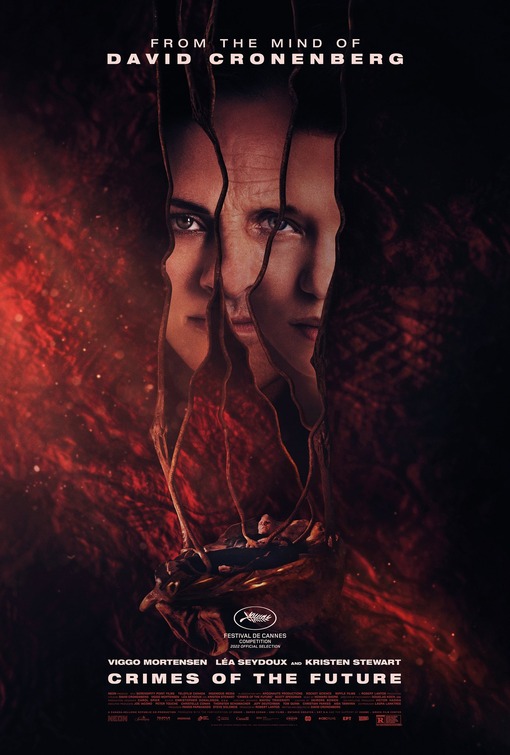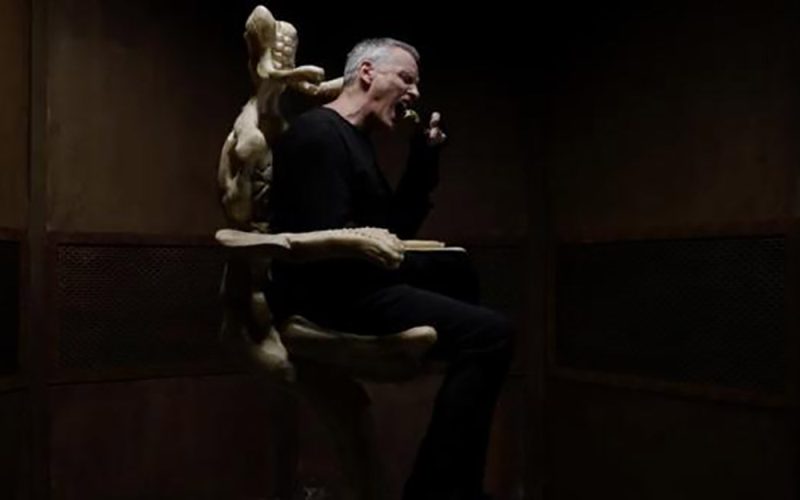
David Cronenberg has been a fixture in cinema for decades. Often associated with horror, science fiction and what is known as body horror, you have probably seen at least two or three of his better known films. I followed his work starting with his classics in the ‘80s like The Brood, Scanners, Videodrome and The Fly. You could always tell that you were watching a Cronenberg production because human beings did such terrible things to themselves or others for pain or pleasure and you would be creeped out or made uncomfortable by the special effects. After a number of years, the auteur has resurfaced with a bizarre glimpse at a future that nobody would want to visit. Crimes of the Future didn’t captivate me with its story despite the fascinating, gruesome effects and made me wish for a better experience in the present.
I’m not certain why Cronenberg decided to reuse the title of an earlier film. It may be simply that other movies with the original title of this new film already existed as he has explained. Regardless of the nebulous title, this future society definitely has some issues. Fortunately, Cronenberg reunites yet again with Viggo Mortensen from A History of Violence, Eastern Promises and A Dangerous Method. While Mortensen provided one of his best performances in Eastern Promises, his character here may be his strangest. Saul Tenser (Mortensen) is a popular performance artist whose shtick involves growing vestigial organs and having his partner Caprice (Léa Seydoux) cut them out of him during the act. Humans have evolved to no longer feel pain, so the performance art feels like a live, human version of the game Operation. A governmental office called the National Organ Registry catalogs Saul’s organs. Run by Wippet (Don McKellar) and his assistant Timlin (Kristen Stewart), a fangirl for Saul’s work, this organization has its own secret agenda. Scott Speedman’s character Lang Dotrice makes purple plastic edible bars because some people are trying to evolve to eat plastic or something. I don’t know. Cronenberg lost me somewhere in the middle, and I just held on for the ride from there. It might all make sense in his head, but I could argue that there’s not much there there.
Mortensen and Seydoux dive body and soul into this story. Unlike the extreme efforts that Mortensen undertook to appear authentic in Eastern Promises, there’s no road map for him to take on this character. Saul has digestive issues, so he grunts and coughs a lot, which led to unintentional laughter in scenes with Stewart, who made her own noises in her terrible performance as Princess Diana in Spencer. Mortensen dresses in black robes like a goth T. E. Lawrence from Lawrence of Arabia or Death in The Seventh Seal. Seydoux last appeared in No Time To Die, and she has made an impression with such varied works as Blue is the Warmest Color and The French Dispatch. Seydoux and Mortensen share a sex scene here that’s less about sex and more about cutting and body modification. Speedman and Stewart have minor roles given their experience. I was more excited to see McKellar, a fellow filmmaker from Toronto like Cronenberg and frequent actor. Look up Last Night and The Red Violin at least.
As much as I cringed in The Fly, it was tough to watch some of the cutting scenes, especially because they seemed so real. Saul and Caprice use a device that looks like a brain and acts like a video game controller or remote surgical robot. As they massage the device, the arms cut and move aside skin and body parts. This may be too much for some people because it has all of the hallmarks of instructional surgery videos. The finale gets even worse. Saul often uses two pieces of “furniture” — a bed with stretchy, fleshy extensions attached to his hands and feet and a chair made of bone-like pieces that helps him eat. Without Mortensen’s acting, these scenes would be comical. Other performance artists’ work and some weird fleshoscopes that Wippet and Timlin use to examine Saul add to the strange future world created by Cronenberg. Kudos to the effects artists for the tall order that they filled. If the visuals don’t turn your stomach, the sound effects just might. All of the devices and equipment operate with squishy noises that showcase the skills of a foley artist.
I have to compare Crimes of the Future with Men because I saw both movies so close in time. Whereas Men had a simple story that went off the rails because of the special effects, Cronenberg’s latest features the special effects in a film with almost no plot as Saul and Clarice go about their lives. Of the two, I still prefer Crimes of the Future because you can at least revel in the weirdness of a Cronenberg release. Howard Shore’s strong musical score emphasizes the drama and keeps it somewhere dark and foreboding. Everything’s dirty and grungy in this world to reflect the state of humanity as opposed to a clean, upbeat future like you might find in dozens of other sci-fi flicks. I hope that Cronenberg continues to make cinema that pushes the boundaries. I would welcome further nightmares from his twisted mind, but Crimes of the Future just didn’t, uh, cut it for me.



